Neutron stars
The stars with an initial mass
of between 8 and 25 solar mass![]() evolve into massive objects
- neutron stars (NS): 1 cm3 of these objects contains a mass of
1 billion tonnes, equivalent to 1 km3 of water.
evolve into massive objects
- neutron stars (NS): 1 cm3 of these objects contains a mass of
1 billion tonnes, equivalent to 1 km3 of water.
The energy radiated from the stars is produced by thermonuclear reactions![]() , the initial hydrogen and helium are transformed into heavier elements: 4 protons are transformed into 1 helium nucleus (He), 3 He nuclei become 1 carbon nucleus and 2 of these
transform into 1 magnesium nucleus; this process goes on up to iron, the nuclear element with the lowest nuclear energy: to obtain heavier elements the reactions should absorb energy. Thermonuclear reactions need higher temperatures when the elements
involved are heavy and the temperature increases in the interior of the star, which will have an onion-like structure,
with iron at the center and hydrogen on the surface.
, the initial hydrogen and helium are transformed into heavier elements: 4 protons are transformed into 1 helium nucleus (He), 3 He nuclei become 1 carbon nucleus and 2 of these
transform into 1 magnesium nucleus; this process goes on up to iron, the nuclear element with the lowest nuclear energy: to obtain heavier elements the reactions should absorb energy. Thermonuclear reactions need higher temperatures when the elements
involved are heavy and the temperature increases in the interior of the star, which will have an onion-like structure,
with iron at the center and hydrogen on the surface.
The star is
in thermodinamic equilibrium, the gravitational collapse being inhibited by the high pressure and temperature; when the thermonuclear reactions are not able to maintain the star in equilibrium, the inner regions quickly collapse. This collapse is speeded up by two processes:
- the iron nuclei
bombarded by high energy gamma photons![]() break into neutrons and helium nuclei, then into protons and neutrons;
break into neutrons and helium nuclei, then into protons and neutrons;
- the protons transform themselves into neutrons and neutrinos by absorbing electrons: the nucleus structure is destroyed.
The core of the star collapses in 50 milliseconds and there is a
huge energy emission
(1053 erg), mainly in the form of
neutrinos emitted in a few seconds: the star is a type II supernova![]() (SN
II).
(SN
II).
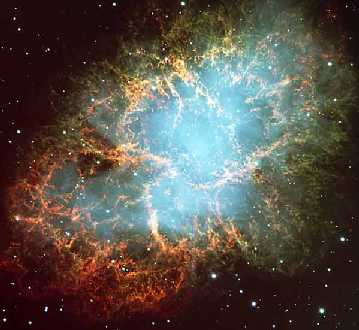 |
Fig. 1: A Crab Nebula image from a VLT telescope (8.2 meters); this oject is a remnant of a SN II explosion
which occurred in 1054 in the Taurus constellation. (Credit: Photo ESO) |
A great amount of mass is scattered in space at around 15000 km/sec and forms many expanding rings(Fig. 2) much more visible than the rings produced by one solar mass star.
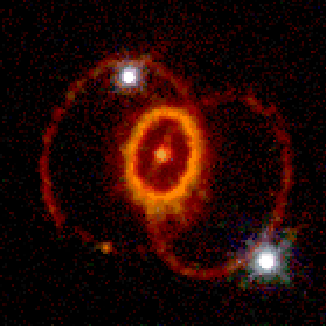 |
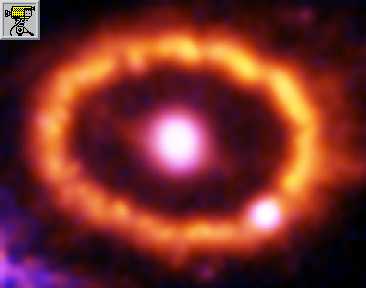 |
| Fig. 2: Supernova 1987a, photo taken by the Hubble telescope (Credit: Photo Nasa, STScI; 21/06/1995) |
Fig. 3: Movie of the supernova 1987a created by assembling the more significant images taken by the Hubble telescope from
September, 24 1994 to November, 28 2003. It is possible to see that the center is weakening while the ring becomes more brilliant. (Credit: Photo and movie Nasa, STScI) |
If the remaining core is less than 3 solar mass![]() the neutron pression can stop the collapse and we obtain a very dense object called
a neutron star (NS).
the neutron pression can stop the collapse and we obtain a very dense object called
a neutron star (NS).
The existence of neutron stars was
mathematically predicted in 1939 by Oppenheimer and Volkoff, although it
had already been foreseen by Baade and Zwicky in 1934, two years after the
discovery of the neutron. The first observation of a neutron star was made by Bell and Hewish in 1969 as a pulsar![]() , a star that emits a periodical radio pulse.
, a star that emits a periodical radio pulse.
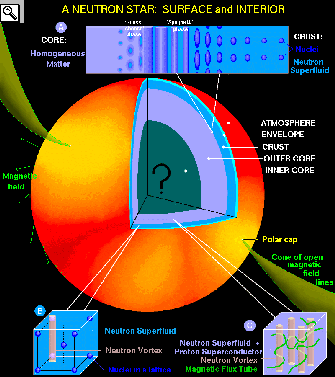 |
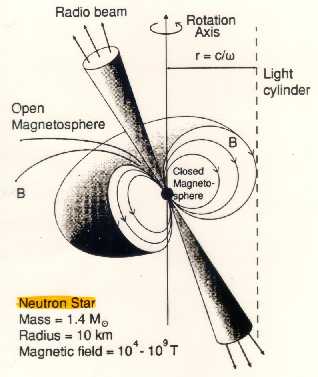 |
| Fig. 4a: Neutron star model; click on the image to see the layers of the star: inner nucleus, outer nucleus, crust,surface and atmosphere. (Credit: D. P. Page (UNAM)) |
Fig. 4b: A pulsar model; a neutron star with a strong magnetic field inclined
in relation to the rotational axis. The radiation (Credit: From "Hight Energy Astrophysics" by M. S. Longair) |
The pulsar is not a pulsating neutron star, but the neutron star rotates around an axis and creates a "lighthouse effect": it is visible only when the light beam is directed towards Earth and we see a short radio beam![]() (sometimes there are even a beam visual and a beam X
(sometimes there are even a beam visual and a beam X![]() ).
).
Unexpectedly the neutron star radius decreases more, the greater the mass of the star.
According to the theory the neutron star mass should be from 0.1 to 3 solar mass![]() , but only neutron stars
with a solar mass from 1.25 and 1.8 have been observed.
, but only neutron stars
with a solar mass from 1.25 and 1.8 have been observed.
At the end of
2003, the international group led by A. Possenti(Cagliari University) and
M. Burgay (Bologna University) observed a double pulsar PSR J0737-3039, a two-neutron star system (Fig. 5) with a short orbital period (2h 30m).
If the collapsed mass is
more than 3 solar mass, the core of the star becomes a black hole![]() .
.
 |
Fig. 5: The two pulsar system PSR J0737-3039 representation and artistic
animation. (Credit: Animation INAF) |